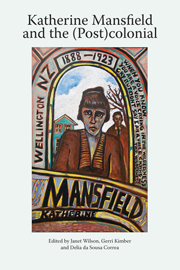Book contents
- Frontmatter
- Contents
- List of Illustrations
- Acknowledgements
- Colophon
- Introduction
- Criticism
- Creative Writing
- Reports
- Reviews
- Vincent O'Sullivan: Frank O'Connor, The Lonely Voice
- Marco Sonzogni: Gerri Kimber and Vincent O’Sullivan, eds, The Collected Fiction of Katherine Mansfield, 1898-1915 (Volume 1) and The Collected Fiction of Katherine Mansfield 1916-1922 (Volume 2)
- Isobel Maddison: Martin Hipsky, Modernism and the Women’s Popular Romance in Britain, 1885-1925
- Brigid Magner: Alex Calder, The Settler’s Plot: How Stories Take Place in New Zealand, and Doreen D’Cruz and John C. Ross, The Lonely and the Alone: The Poetics of Isolation in New Zealand Fiction
- Alexandra Smith: Galya Diment, A Russian Jew of Bloomsbury: The Life and Times of Samuel Koteliansky
- Notes on Contributors
- Katherine Mansfield Society
Isobel Maddison: Martin Hipsky, Modernism and the Women’s Popular Romance in Britain, 1885-1925
from Reviews
Published online by Cambridge University Press: 05 March 2014
- Frontmatter
- Contents
- List of Illustrations
- Acknowledgements
- Colophon
- Introduction
- Criticism
- Creative Writing
- Reports
- Reviews
- Vincent O'Sullivan: Frank O'Connor, The Lonely Voice
- Marco Sonzogni: Gerri Kimber and Vincent O’Sullivan, eds, The Collected Fiction of Katherine Mansfield, 1898-1915 (Volume 1) and The Collected Fiction of Katherine Mansfield 1916-1922 (Volume 2)
- Isobel Maddison: Martin Hipsky, Modernism and the Women’s Popular Romance in Britain, 1885-1925
- Brigid Magner: Alex Calder, The Settler’s Plot: How Stories Take Place in New Zealand, and Doreen D’Cruz and John C. Ross, The Lonely and the Alone: The Poetics of Isolation in New Zealand Fiction
- Alexandra Smith: Galya Diment, A Russian Jew of Bloomsbury: The Life and Times of Samuel Koteliansky
- Notes on Contributors
- Katherine Mansfield Society
Summary
Modernism and the Women’s Popular Romance in Britain, 1885-1925 is an important and masterful analysis of the romance novel set in the wider context of emerging modernism and the notable shift in the literary hierarchies that accompanied it. The express intention of the book is to redress the ‘romance gap in our literary-historical record’ by focusing on a small group of romances that best exemplify ‘the meteoric rise of once best-selling texts’ (xii) by authors such as Mary Ward and Marie Corelli.
This sounds as though it could be an analysis that attaches importance to the notion of limited literary classifi cation, especially because the Introduction and first chapter alert us to hierarchies of artistic and cultural ‘brows’ into which we might slip thoughtlessly the romances under discussion. This is not Hipsky’s aim, however. Rather, he offers a challenge to twenty-first century scholars of modernism and illuminates the ‘continuities and frictions’ (xiii) between those texts considered popular and those deemed to be modernist in what he calls a ‘zone of convergence’ (xv). Instead of focusing on narrative and stylistic differences, his argument centres on commonality and ‘complementarity of affect’ (219). He suggests, for instance, that the best-selling romances of 1885–1925 offer representations of interiority that parallel the ‘more self-conscious forms of psychic intensity’ (xv) explored by, amongst others, Mansfi eld, Woolf and Lawrence. He is persuasive in connecting the quest for moments of modernist transcendence with the climatic, ‘escapist’ scenes of several romance novels, which also, like Mansfield’s ‘blazing moments’ in particular, foreground the ultimate impossibility of achieving such a goal.
- Type
- Chapter
- Information
- Katherine Mansfield and the (Post)colonial , pp. 199 - 201Publisher: Edinburgh University PressPrint publication year: 2013



